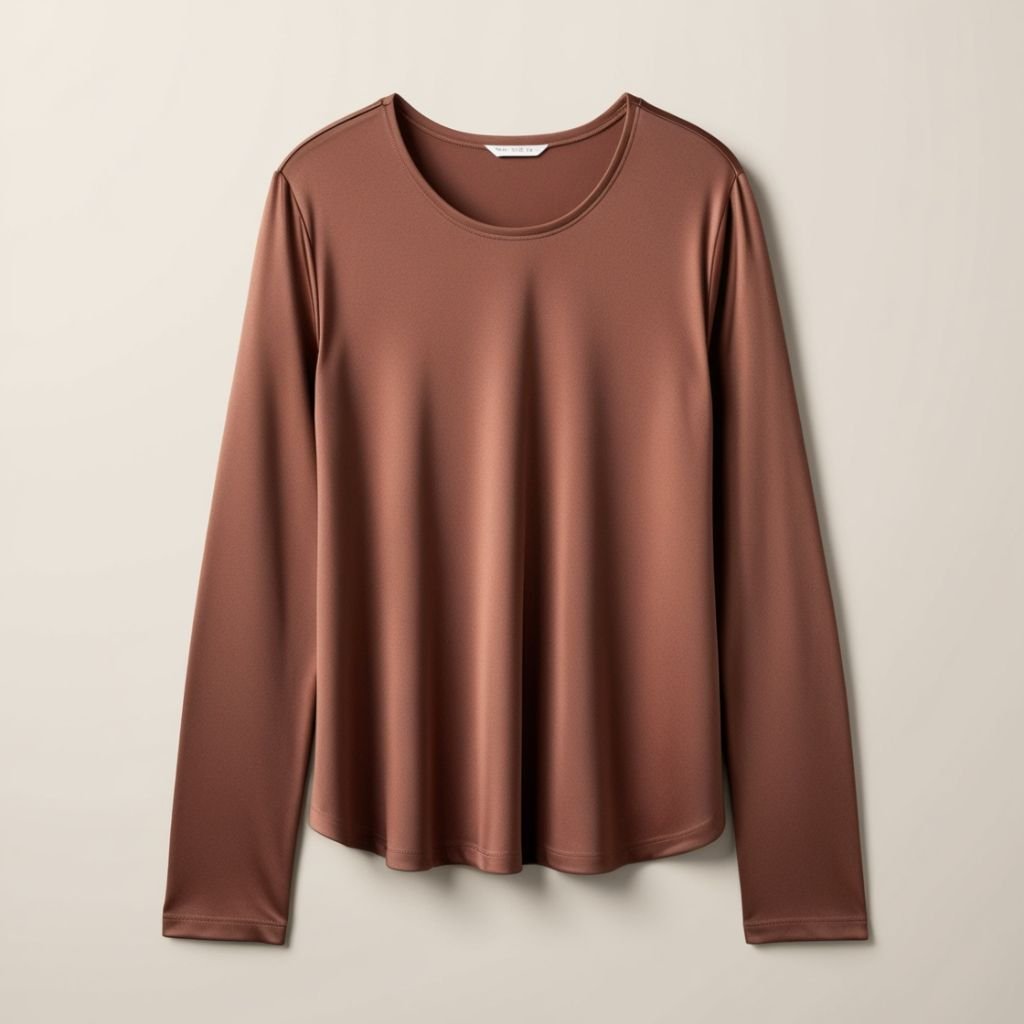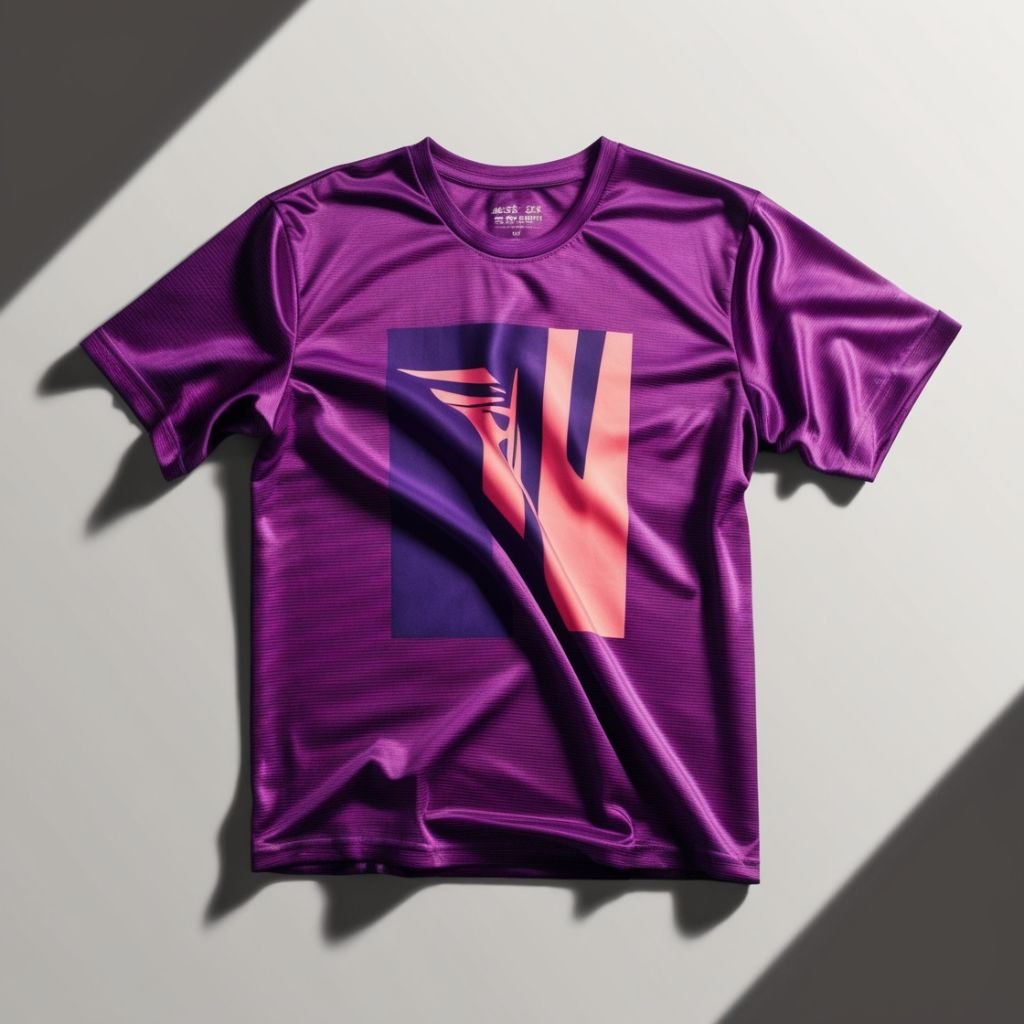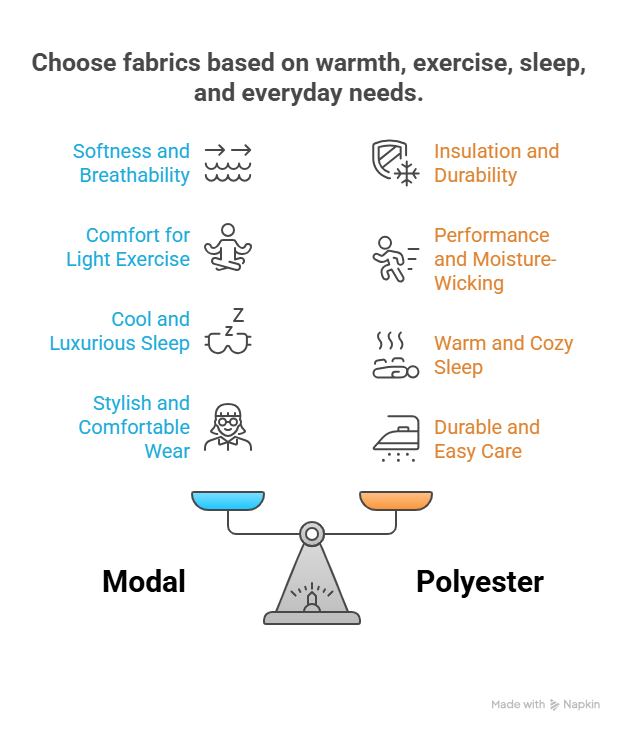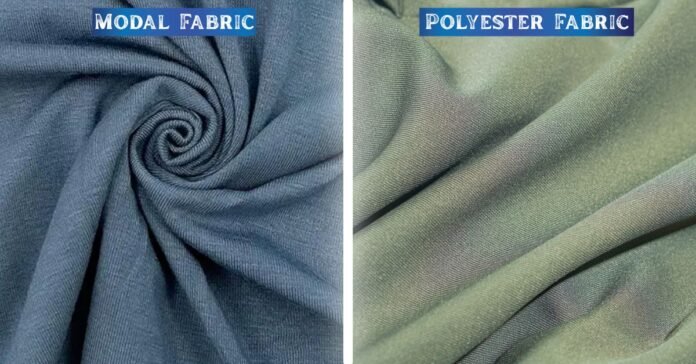Introduction-
Choosing the right fabric often comes down to warmth, comfort, and performance. Modal and polyester are two very different materials used in clothing and bedding. Modal is a semi-synthetic rayon made from beech-tree pulp. It is prized for its cloud-like softness and high absorbency. Polyester is a 100% synthetic fiber made by polymerizing petroleum-derived compounds. It is known for its strength, quick-drying nature, and durability. The key question is: Is modal warmer than polyester?
This matters for everything from winter jackets to summer T-shirts, from bedding to activewear. A fabric that traps heat can keep you warm in cold weather, while a highly breathable fabric may let heat escape and keep you cool. We’ll compare modal and polyester on warmth, breathability, seasonal use, and more, drawing on textile data and expert guides.
What is Modal?
Modal is a semi-synthetic cellulosic fiber made from the cellulose in beechwood pulp. Technically a type of rayon, modal undergoes chemical processing but starts with a natural wood source. It is often described as feeling “soft as a cloud” or “silky” on the skin. Modal’s fibers are very smooth and fine, giving fabrics an extremely soft hand and elegant drape.
Because of this structure, modal fabrics have excellent breathability and moisture-wicking. The fibers have tiny micropores that can absorb and release water vapor efficiently. In practice, modal can absorb about 50% more moisture than cotton. It pulls sweat away from the body and lets it evaporate, which helps keep the wearer cool and dry. For example, modal is often used in activewear and underwear for this reason.

In short, modal’s properties include:
- Softness and comfort – feels smooth and gentle on skin.
- Breathability – lets air circulate freely, avoiding overheating.
- Moisture absorption – wicks sweat away for a cooling effect.
- Good drape and durability – long fibers resist pilling and maintain shape.
What is Polyester?
Polyester is a fully synthetic fabric. Chemically, it is usually polyethylene terephthalate (PET) made from petroleum-based ethylene glycol and terephthalic acid. Unlike modal’s wood pulp origin, polyester is derived entirely from fossil fuels. It was invented in the 1940s and has become the most widely used textile fiber globally.
Polyester’s properties are almost opposite modal’s in some ways:
- Durability: Polyester fibers are very strong and long-lasting. They resist stretching, tearing, and abrasion. A polyester garment retains its shape and resists shrinkage even after many washes.
- Moisture management: Polyester repels liquid moisture rather than absorbing it. It tends to push sweat to the fabric surface to evaporate (making it quick-drying). This wicking action helps keep polyester garments feeling relatively dry.
- Insulating ability: Polyester fibers can trap air between them, giving the fabric some insulating warmth. We will explore how this makes polyester generally warmer than modal.
- Low maintenance: Polyester is wrinkle-resistant, colorfast, and easy to care for. It washes well on any temperature, dries fast, and rarely needs ironing.
- Feel: Modern polyester can be quite soft (often described as silky and lightweight on the skin), but it still usually feels more “synthetic” or smooth rather than plush.

Thermal Properties: Is Modal Warmer Than Polyester?
The core of this comparison is warmth. Does one fabric hold in more heat? In general, polyester tends to be warmer than modal. This is because polyester’s tight, synthetic fibers trap body heat and moisture more than modal’s open, breathable structure. For instance, outdoor and sports apparel companies highlight that polyester garments are “great at holding onto heat,” making them popular for cold-weather gear. The guide notes that polyester’s tightly woven fibers trap body heat, helping you stay warm when it’s cold.
In contrast, modal is designed to release heat, not hold it. Its high breathability means warm air escapes quickly. One source explicitly states that “modal fabric exhibits superior heat management compared to polyester” – meaning modal allows heat out. Another fabric guide warns “breathability in modal comes at a cost: its inability to keep you warm”. In practical terms, a 100% modal sweater will generally feel lighter and cooler than a similar polyester sweater.
Fabric thickness and weave matter too. A thicker fabric traps more still air, which acts as insulation. For both modal and polyester, heavier or brushed fabrics will be warmer than light ones. However, even a thick modal fleece would likely not insulate as much as an equivalent polyester fleece, because modal fibers transfer heat faster. In summary, polyester generally retains more warmth due to its structure, while modal’s open weave and moisture-absorbency keep the wearer cooler. In a “fabric showdown,” polyester has the edge for heat retention.
Seasonal Suitability: Best Times to Wear Each
Best Fabric for Winter: Polyester
For cold weather, polyester is often the better choice. Its fibers trap heat and resist cold air penetration, making it a natural fit for winter layers. For example, polyester fleece jackets and insulated jackets rely on polyester’s heat retention. A textile guide explains that polyester’s fibers are “tightly woven” to trap body heat, which is especially handy in jackets and blankets for winter sports. Thermals and base layers frequently use polyester or polyester blends because they both insulate and wick away sweat. In practice, a 100% polyester hoodie or scarf will feel warmer than one made of modal or cotton. However, note that polyester alone won’t breathe much, so it’s often worn in layers or ventilated designs to balance comfort.
Best Fabric for Summer: Modal
In hot weather, modal shines. Its breathability and moisture absorption make it ideal for summer garments. Modal T-shirts or dresses let air flow and pull sweat away from the body, keeping the skin relatively cool. One fashion guide explicitly recommends modal for warm months, noting its lightweight nature and ability to handle humidity. While polyester dries quickly when sweaty, a pure polyester tee can still feel hot without vents. Some activewear uses polyester blends with mesh to improve airflow, but modal by itself often feels airier. In summary, reach for modal on a summer day when you want cooling comfort.
In short: For winter cold, polyester (or a polyester blend) is usually better, while for summer heat, modal fabrics are preferable. Modal can also serve as a comfortable middle-layer in cool but not frigid climates.
Comfort & Feel: Which One Feels Better?
Modal Fabric
Texture and softness are key comfort factors. Modal is widely praised as a very soft, luxurious fabric. Its long, smooth fibers give it a delicate, “silky” hand. Many users compare modal’s feel to that of cotton or silk. As one source says, modal “exudes an elegant beauty” with a gentle and refined texture. It feels cool against the skin and drapes nicely. Because of this, modal is often chosen for underwear, sleepwear, and bedding — applications where softness is paramount. Modal also has minimal static cling and is hypoallergenic for sensitive skin.
Polyester
Polyester’s feel depends on its construction. Early polyesters were coarse, but modern polyester knits can be quite soft. In fact, polyester is often described as light, silky, or “airy” on the body. It was noted that polyester feels “silky and airy” and can be even softer than cotton. However, polyester still has a somewhat synthetic quality. A plain polyester weave can sometimes feel smooth but not as plush as modal. It also tends to generate more static, which can cause cling in dry conditions (unlike modal).
Beyond feel, practical comfort matters too. Polyester’s tight weave offers advantages: it can block wind and light rain better than modal. For example, a polyester windbreaker will cut more wind than a modal shirt. So while modal wins on softness, polyester can feel more protective in rough weather.
Durability & Care Requirements
Both modal and polyester are good in their survivability, yet they require different maintenance.
Polyester: The durably constructed one
Polyester is strong. It is non-shrinking, non-wrinkling and does not fade. It does not require a lot of care and it survives the washing machine. In a contest of longevity, polyester is a definitely winner.
Modal: Fine yet Gentle to Deal With
Modal is stiff and when it gets wet it becomes weak. If not properly washed it might shrink. It needs soft washing but because it is so soft and it performs so well doing it is worth the extra bit of care taken.
Environmental Impact
When it comes to ecology, modal and polyester lie at opposite ends. Modal comes from beech trees, a renewable resource. It is biodegradable in ideal conditions, since it’s based on natural cellulose. Modal’s production can be relatively eco-friendly if done responsibly: it typically uses less water and energy than cotton and often uses a closed-loop process to recycle chemicals. Some modal is marketed as “sustainable” TENCEL™ modal, emphasizing certified wood sources and cleaner production.
However, modal’s environmental downsides include the use of toxic chemicals (e.g. carbon disulfide in viscose-derived processes) and sometimes unsustainable forestry practices. In fact, certain modal production has been linked to deforestation when not certified. So modal is more eco-friendly than polyester, but it’s not perfect unless sourced responsibly.
Polyester has a much larger environmental footprint. It is made from non-renewable petroleum, and its production is energy-intensive. It was warned that polyester fabrication “has major environmental drawbacks,” including heavy fossil fuel use, high CO₂ emissions, and the persistent problem of microplastics. Polyester is not biodegradable; garments can last for decades in landfill.
Additionally, washing polyester releases synthetic microfibers into water systems. Studies estimate 16–35% of global microplastic pollution comes from textile washing. The European Environment Agency confirms that wearing and washing synthetic fabrics like polyester is a recognized source of microplastics entering oceans. In other words, even laundry can harm ecosystems due to polyester.
User Scenarios: Which Fabric to Choose?
Choosing between modal and polyester often depends on the use-case:

- For Extra Warmth: If staying warm is the priority (e.g. insulation in cold climates), polyester is generally better. A 100%-polyester thermal shirt or fleece jacket will hold heat far more than a modal one. Polyester’s insulating fibers and moisture-wicking keep you cozy even if you sweat. Modal alone would not suffice in extreme cold. Instead, modal can serve as a soft middle layer to add comfort under a polyester outer shell.
- For Workouts and Activewear: Polyester typically wins for intense exercise. Its quick-dry moisture-wicking keeps sweat off your skin, and its durability withstands frequent wash cycles. Many running and gym clothes use polyester (or blends) for this reason. Modal can be comfortable for light exercise or yoga, but heavy sweating may leave it damp. In short, athletes often prefer polyester or poly-blends for performance, and modal for post-workout comfort.
- For Sleepwear: For pajamas and bedding, modal is often preferred. Its breathability and softness make modal pajamas feel cool and luxurious against the skin. In warm nights, modal’s moisture absorption prevents sticking. On the other hand, for cold nights some may like polyester or flannel pajamas to add warmth. For example, many blankets and heavy robes are polyester fleece. If you tend to sleep cold, a polyester-blend pajama or a polyester blanket can add insulation. But for everyday sleepwear in moderate climates, modal’s comfort is hard to beat.
- For Everyday Clothing: In casual wear like T-shirts, dresses or underwear, modal is often chosen for comfort (think stylish modal dresses or underwear). Polyester is common in work shirts, blouses, and outerwear where durability and ease of care matter.
Common Myths & Misconceptions
Myths about modal and polyester: The skinny on a few:
Modal is warm all-time.
Not true. Modal has no insulation quality. It does not keep you warmer, it is cooler to wear. Thermal tests show that polyester has a higher amount of heat than modal.
Polyester Doesn’t Not Breathe
Polyester is breathable it depends on how the fabric is made. Namely, moisture-wicking poly blends are tailored to enhance the quality of airflow and comfort.
What Experts & Studies Say
These claims are supported by an expert in the Science of textile. As observed by a published study by Textile Research Journal, polyester is found to have more than 25 percent greater thermo-insulation properties as compared to modal. Polyester in winter wear credit can be given to leading brands such as Patagonia and Uniqlo because they actually efficient.
Textile experts also observe that modal is used in the hotter areas because it is soft and cool in nature. Conversely, polyester constitutes performance clothes and winter-related clothes due to its warmth properties.
Conclusion-
In the debate “Is modal warmer than polyester?”, the answer is clear: no, polyester is generally warmer. Polyester’s tightly woven synthetic fibers trap heat and hold you warmer in cold conditions. Modal, in contrast, is very breathable and moisture-absorbent, so it tends to feel cooler on your body. However, this does not mean one fabric is “better” overall—each has its strengths. Modal’s super-soft, natural feel and moisture-wicking make it excellent for comfort in mild or hot weather. Polyester’s durability, shape retention, and insulation make it ideal for cold weather, sportswear, and heavy-use items.
Recommendations: For cold-weather wear, reach for polyester or blends. For summer or loungewear, modal is a superb choice. For activewear, polyester’s moisture-wicking will keep you drier during exercise, while modal will feel softer when relaxing.
Ultimately, consider your priorities: Do you need warmth or cool comfort? Now that the facts are in, you can choose the fabric best suited to your needs.
